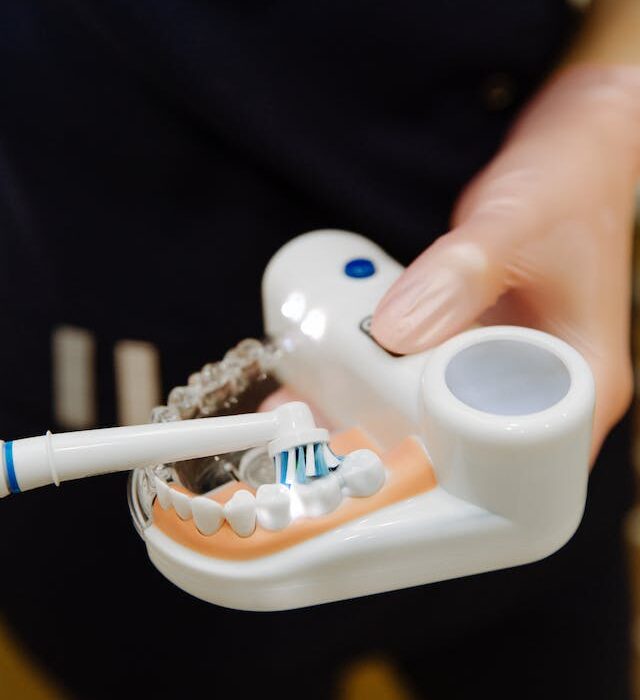A cavity between teeth refers to any condition whereby small holes or pits form in the hard outer layer of a tooth’s enamel (its outer shell). When this condition arises between teeth, dental hygiene becomes even more challenging due to tight spaces preventing efficient cleaning practices from being possible. Here are some important facts regarding cavities between teeth:
Causes: Cavities can often be traced back to bacteria present in the mouth, sugar from food and beverages consumed, as well as poor dental hygiene practices. Bacteria feed on sugars to produce acids which erode tooth enamel causing cavities.
Symptoms: Cavities between teeth may not produce noticeable symptoms in its early stages; however, as they progress further they could manifest as tooth sensitivity, pain when chewing, visible holes on affected teeth or dark spots on them – these being potential indicators that an infection exists and needs attention immediately.
Diagnosis: Dentists can detect cavities between teeth during a dental examination using visual inspection, dental instruments or dental X-rays to locate them.
Treatment: Dental fillings are often recommended to address cavities between teeth. Dentists will remove the decayed part of the tooth before filling the cavity with materials like amalgam, composite resin or porcelain filler to restore tooth strength and appearance. In more serious cases, however, a dental crown may be required in order to strengthen and preserve the tooth’s strength and appearance.
Prevention: Preventing cavities between teeth requires practicing good oral hygiene practices, including brushing twice per day with fluoride toothpaste, flossing daily to clean between your teeth and remove plaque buildup, and visiting your dentist at least every six months for regular check-ups and cleanings.
Interdental Cleaning: In order to effectively prevent cavities between teeth, interdental cleaners such as dental floss, interdental brushes or water flossers must be utilized in order to effectively reach those spaces between your teeth that a traditional toothbrush cannot.
Dietary Choices: Reducing sugary and acidic consumption may help decrease the risk of cavities. Also try not snacking frequently as this exposes teeth more often to sugars that could stain enamel over time.
Fluoride: Utilizing fluoride-containing dental products such as toothpaste and mouthwash may strengthen enamel and increase resistance against cavities, helping make teeth stronger overall.
If you suspect a cavity between your teeth, or have concerns about the health of your dental environment, it’s essential that you arrange an appointment with a dentist as early detection and treatment can keep the cavity from worsening and leading to more significant dental problems later.
Signs and Symptoms of a Cavity Between the Teeth
A cavity, also referred to as dental caries or tooth decay, can form between your teeth just like it can on their surface, though early stage detection of such cavities between the teeth is difficult as they’re less visible. Here are some signs and symptoms which might indicate there’s one between your teeth:
Tooth Sensitivity: Sensitivity to hot or cold food or beverages may be an early warning sign that there may be cavities between your teeth. You might experience sharp, shooting pain when consuming anything hot or cold.
As your cavity progresses, it may cause pain or discomfort in the affected area.
Visible Discoloration: As cavities develop on your tooth surface, discoloration is sometimes visible on its surface as brown, black, or white spots or stains develop near their site of formation.
Floss Snagging: While flossing between your teeth, you might experience your floss catching or snagging on a rough edge or sharp corner; this could indicate there is decay present there and needing immediate treatment.
Bad Breath: Cavities can lead to bad breath due to bacteria-laden decayed tooth material and plaque build-up in your mouth, and this bacteria-filled environment.
As your cavity progresses and worsens, you may experience pain or discomfort when biting down or chewing food.
Visible Holes or Pits: At more advanced stages, if an affected tooth lies between your molars or is otherwise easily visible in a mirror, you may detect visible holes or pits on its surface.
Swelling or Pus: If a cavity becomes severely infected, swelling around it or pus discharge may indicate advanced and serious dental infection. This would indicate an advanced and serious dental infection is developing.
Noticing cavities early is key, since their development often does not cause noticeable symptoms in its early stages. Dentists can detect cavities between teeth through X-rays and visual inspection, often before any discomfort or visible changes arise.
If you suspect a cavity between your teeth, or experience any of its associated symptoms, it’s imperative that you visit a dentist promptly for diagnosis and treatment. Early intervention could save the cavity from worsening further and may prevent more extensive dental issues in its wake.
Can cavities between teeth be fixed?
Yes, cavities between teeth can be repaired using various dental procedures and techniques. Interproximal cavities, commonly referred to by dentists as interproximal caries can often be addressed using dental fillings – this process typically works:
Diagnosis: Your dentist will initially detect a cavity through a visual exam, taking dental X-rays or employing other diagnostic tools.
Anesthesia: When needed, dentists may administer local anesthetic to ensure an effortless procedure and alleviate any potential discomfort during dental work.
Removing Decay: Your dentist will use dental instruments to remove decayed portions between teeth using special instruments that target enamel and dentin damage to create an even surface and clear surfaces for future care.
Dental Fillings: Once decay has been eliminated, a dentist will fill any cavities left with dental filling material such as amalgam (silver-colored fillings) or composite resin (tooth-colored fillings). They’ll shape and polish it until its appearance matches that of natural tooth contours for maximum comfort in between teeth.
Final Adjustments: Your dentist will check to ensure the bite is even and comfortable, and may make further modifications as necessary.
Cavities between teeth should be addressed as soon as they are detected to avoid further damage and complications. Left untreated, these cavities could expand over time and require extensive dental work like crowns or root canals in order to properly treat.
Regular dental examinations and good oral hygiene practices such as brushing and flossing can help protect against interproximal cavities from occurring altogether.
How long can you keep a cavity untreated?
I’m not a dentist, but I can provide some general information about untreated cavities. The progression of a cavity can vary depending on several factors, including the individual’s oral hygiene, diet, and the location and size of the cavity. It’s important to note that cavities do not heal on their own; they only worsen over time.
If a cavity is left untreated, it can continue to grow and eventually reach the inner pulp of the tooth, leading to more serious problems such as infection, severe pain, and the potential loss of the tooth. The timeline for this progression can vary from several months to several years, and it can be influenced by the factors mentioned earlier.
It’s essential to address cavities promptly by visiting a dentist for proper evaluation and treatment. Early intervention can often prevent the need for more extensive and costly dental procedures down the line, such as root canals or tooth extractions. Regular dental check-ups can help catch cavities in their early stages, allowing for simpler and less invasive treatments like fillings.
Does filling cavities in between teeth hurt?
Filling cavities between teeth usually doesn’t cause much pain during the procedure itself; your dentist can use local anesthesia to numb the area before beginning. Local anesthesia numbs nerve endings around the tooth to make this step relatively pain-free.
Although no pain will likely result from dental anesthesia, you might experience mild discomfort or pressure while the dentist works on their cavity. Pressure sensations could still exist even without feeling actual discomfort due to anesthetic medication being applied directly on your mouth.
Once the procedure is over, some mild discomfort or sensitivity might arise after taking out your anesthesia – however this should usually be manageable using OTC pain relievers and should resolve itself within days. Rarely however, post-operative discomfort or sensitivity could persist beyond a couple of days but should subside without incident or become manageable using over-the-counter drugs.
If you experience pain during dental procedures, it’s essential that you speak up. They may provide additional anesthesia or suggest methods of making you more comfortable during treatments. Furthermore, regular check-ups and treating cavities promptly may prevent more significant issues and minimize discomfort during procedures.
How long does it take to fill a cavity in between teeth?
Time taken to fill an interdental cavity can depend on several variables, including its size and location; filling material used; expertise of the dentist and more. On average, however, dental filling procedures typically last 20 – 60 minutes with this rough breakdown:
Exam and Diagnosis: Before providing treatment, your dentist will begin by conducting an in-depth dental exam and performing an X-ray exam to ascertain the extent of any cavities present and determine if fillings will be needed to repair them.
Numb the Area: Prior to commencing their procedure, your dentist will administer local anesthetic to numb the area around your affected tooth so as to reduce pain during any necessary procedures. This should help ensure an enjoyable and pain free experience during any necessary treatments or extractions.
Removing Decay: For this step, your dentist may use either a dental drill or laser to extract decayed portions from the tooth using either mechanical means (drill/laser) or manual means (scraper/chisel). Time taken may depend on the size and depth of the cavity present.
Cleaning and Preparing the Tooth: Once decay is eliminated, a dentist will clean and prepare the tooth in preparation for filling, which may include etching the surface to enhance adhesion of filling material to teeth.
Filing Installation: After cleaning and prepping a cavity, your dentist will use his/her chosen filling material (composites resin, amalgam or glass ionomer) to place into it. Time spent here depends upon type and complexity of filling.
Shaping and Polishing: Once completed, a dentist will shape and polish the filling to make sure it fits securely and blends in seamlessly with its surroundings. This step may take up to several minutes.
Fillings for smaller cavities generally take 20-30 minutes to complete; more complex or larger cases could take more time; your dentist can give a more precise estimation based on your unique circumstances. It’s also essential to keep in mind that thoroughness and precision from your dentist play an integral part in creating successful and long-lasting fillings.

